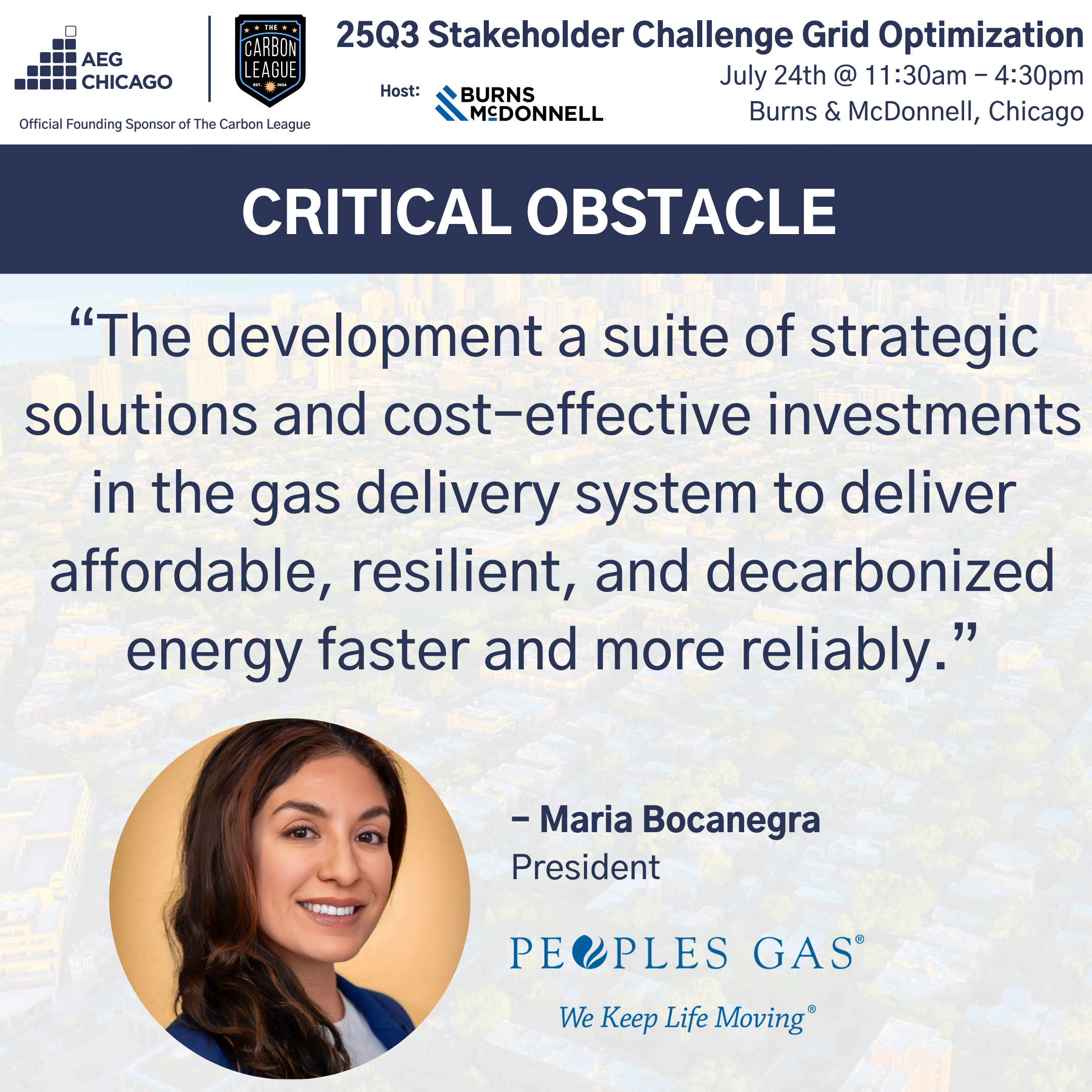Executive Summary: July 24th AEG Chicago Stakeholder Challenge: Grid Optimization
Overview
Held on July 24th, 2025 at Burns & McDonnell in Chicago, IL, fifty public and private industry leaders convened for the AEG Chicago Stakeholder Challenge: Grid Optimization. The purpose of this challenge was to: 1.) Agree on a critical obstacle preventing achievement of Chicagoland’s climate, health and energy goals; 2.) Align on a 90-day sprint and 12-month objective to best address this obstacle; and 3.) Enable stakeholders to create a volunteer Task Force accountable for delivering the agreed solution.
Michael Rutkowski, Managing Director, 1898 & Co. and Doug Scott, Chairman, Illinois Commerce Commission, provided opening remarks to frame the discussion surrounding grid optimization for Chicagoland and Illinois.
Opening remarks were followed by the Speaker Challenge, where each speaker provided an 8 minute and 5 slide presentation that concluded with this completed statement: "Regarding Grid Optimization, to achieve Chicagoland's climate, health & energy goals, a critical obstacle to collectively overcome in 12 months is …”
5 Key Themes
1. Interoperability as a Foundation for Grid Modernization
The lack of interoperable control systems across devices—especially at the grid edge—is limiting the scalability of DERs, EVs, and other advanced grid technologies. A clear roadmap and stakeholder alignment on interoperability standards is essential.
“ComEd must be able to manage this communication-enabled, data-intensive, and grid-edge-controllable grid through an interoperable architecture.” – Brooks Glisson, ComEd
2. Building the Skilled Workforce Required for the Grid of the Future
Chicagoland’s energy transition is at risk due to an aging trade workforce and lack of pathways for new entrants. A clearly defined “skills bridge” is needed to fill critical manufacturing, utility, and technical roles.
“Without a skill bridge to bring in new talent, we risk hindering innovative solutions, the pace of the energy transition, and local wealth creation.” – YaLonda Lockett, S&C Electric
3. Leveraging Existing Gas Infrastructure for Faster, Affordable Decarbonization
Optimizing energy planning by co-integrating gas and electric systems can reduce redundancy, lower costs, and accelerate decarbonization. Current electric-only grid planning may overinvest and delay critical transitions.
“Planning without gas overlooks a faster, scalable path to decarbonization using existing assets.” – Maria Bocanegra, Peoples Gas
4. Unlocking Clean Capacity Through Interregional HVDC Transmission
To address capacity shortfalls and reduce price volatility in MISO and PJM, Illinois must build and procure long-term clean capacity—including interregional HVDC lines that connect high-capacity renewables across regions.
“Illinois must act now to secure new clean capacity... Long-term contracts for HVDC renewables can hedge against auction volatility and ensure resource adequacy.” – Steve Frenkel, Invenergy
5. Community-Led Demonstration Projects for Localized Impact
Local pilot projects in communities like Rockford, Carbondale, and Auburn Gresham should serve as testbeds for implementing interoperable technologies, workforce solutions, and dual-fuel strategies. These models can inform scalable, statewide action.
“Develop and present a virtual pilot concept with roadmap for each community to deploy interoperable DER, gas delivery, and workforce solutions.” Adapted submission Table 5/6
Inspired by the statement provided by Maria Bocanegra (President, People’s Gas), participants agreed to prioritize her obstacle statement. Participants then designed, pitched, and selected a 90-day sprint and 12-month objective to best address this critical obstacle. 11 leaders came together to form a volunteer Task Force to complete the 90-day sprint and 12-month objective.
Task Force Volunteers: Tim Condon, JLL, Michael Rutkowski, 1898 & Co., Renée Skeete, Argonne National Laboratory, Angelo Lo Nigro, RINA, Aaron McEvoy, State of Illinois - DCEO, Christine Flynn, Workforce Policy Lab, Gregory Norris, ISEEJustice40, Ladi Ogunnubi, Kootanla, Kelly Matuszewski, Northwestern University, Spenser Nelson, The Carbon League, Michael Thuis, The Carbon League
To join this group of volunteers who aligned on this critical obstacle and developed this 12 month goal and 90 day sprint, please contact us at info@goadvancedenergy.com.
Conclusion
The AEG Chicago 25Q3 Stakeholder Challenge on Grid Optimization convened utility innovators, infrastructure planners, workforce leaders, and energy policy experts to confront the region’s most pressing grid challenges. The challenge highlighted the need to integrate interoperable DERs, build a skilled workforce for grid modernization, and co-optimize gas and electric infrastructure for affordability and resilience. Key themes included unlocking clean capacity through interregional HVDC transmission, accelerating community-led pilot projects, and ensuring alignment between planning and execution across technologies and sectors. As volunteer task force members advance a 90-day sprint and 12-month roadmap, their work will be instrumental in delivering a more reliable, efficient, and equitable energy future for Chicagoland and Illinois.
Access to private resource pages, which include speaker presentations, from AEG Stakeholder Challenges are reserved for Signature Sponsors and City/Government Partners. To become a Signature Sponsor, learn more here: https://aeg.team/engage






